Functions of HR in an Organization: Analysis of Objectives and Models
VerifiedAdded on 2022/11/25
|17
|4811
|92
Report
AI Summary
This report delves into the multifaceted functions of Human Resources (HR) within contemporary organizations, emphasizing the critical role HR plays in enhancing employee performance and achieving organizational goals. It explores key HR functions such as recruitment, orientation, maintaining working conditions, employee relations, and training. The report outlines the core objectives of HR, including managing employee turnover, fostering organizational growth, boosting productivity, and promoting employee engagement, and discusses how these objectives are evolving. It also justifies the importance of managing HR professionally, ethically, and justly. Furthermore, the report analyzes different models for delivering HR objectives, specifically the Shared Services Model and the Outsourcing Model, and examines how HR functions vary across different sectors and organizational sizes. The report also explores the concept of change management, providing explanations of Lewin's and Kotter's change management theories, illustrating how these theories can be applied and evaluated within an organizational context. The report provides a comprehensive overview of HR's strategic importance in modern business environments.

Running head: FUNCTIONS OF AN HR IN AN ORGANIZATION
FUNCTIONS OF AN HR IN AN ORGANIZATION
Name of the student:
Name of the university:
Author Note:
FUNCTIONS OF AN HR IN AN ORGANIZATION
Name of the student:
Name of the university:
Author Note:
Paraphrase This Document
Need a fresh take? Get an instant paraphrase of this document with our AI Paraphraser
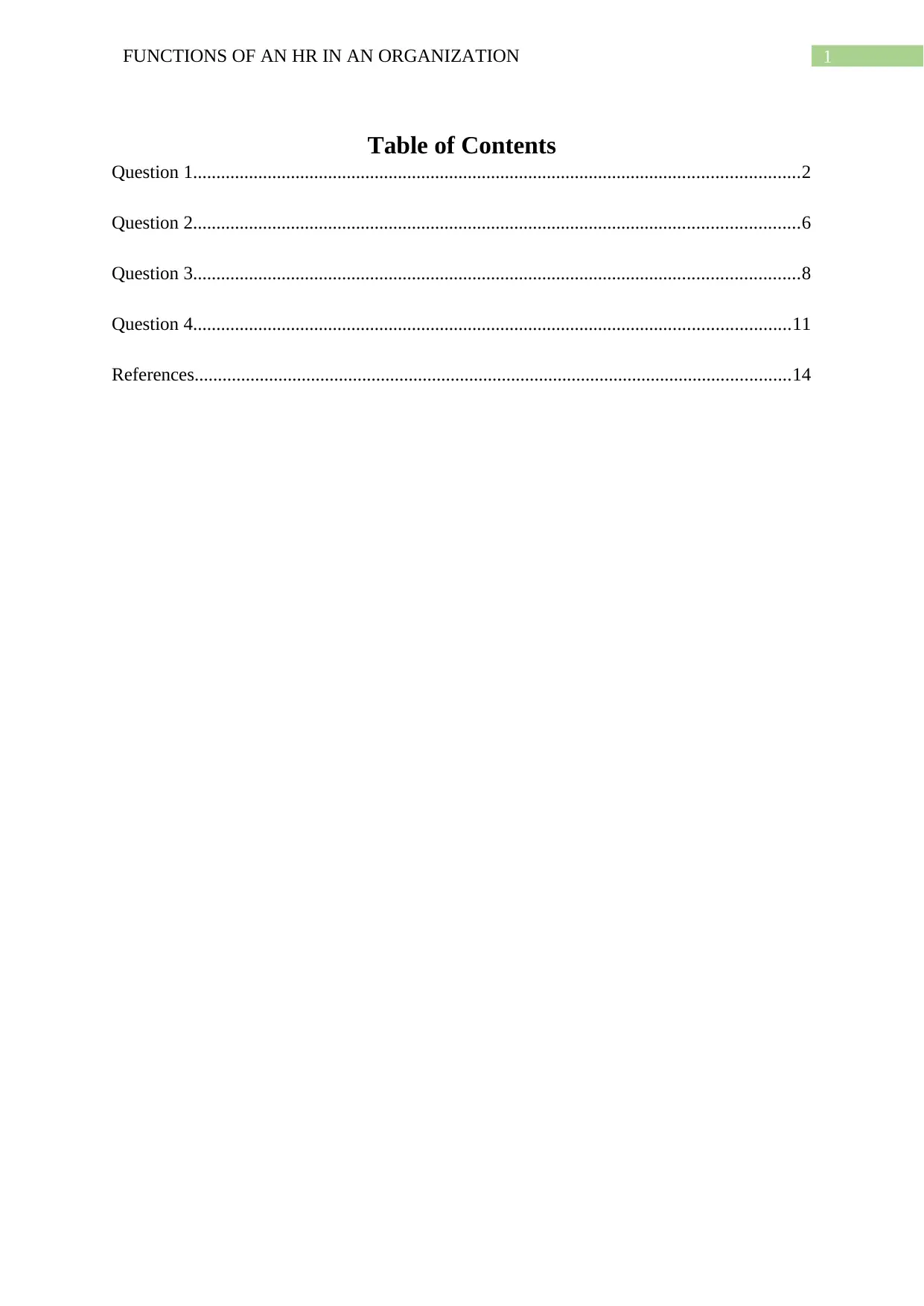
1FUNCTIONS OF AN HR IN AN ORGANIZATION
Table of Contents
Question 1..................................................................................................................................2
Question 2..................................................................................................................................6
Question 3..................................................................................................................................8
Question 4................................................................................................................................11
References................................................................................................................................14
Table of Contents
Question 1..................................................................................................................................2
Question 2..................................................................................................................................6
Question 3..................................................................................................................................8
Question 4................................................................................................................................11
References................................................................................................................................14
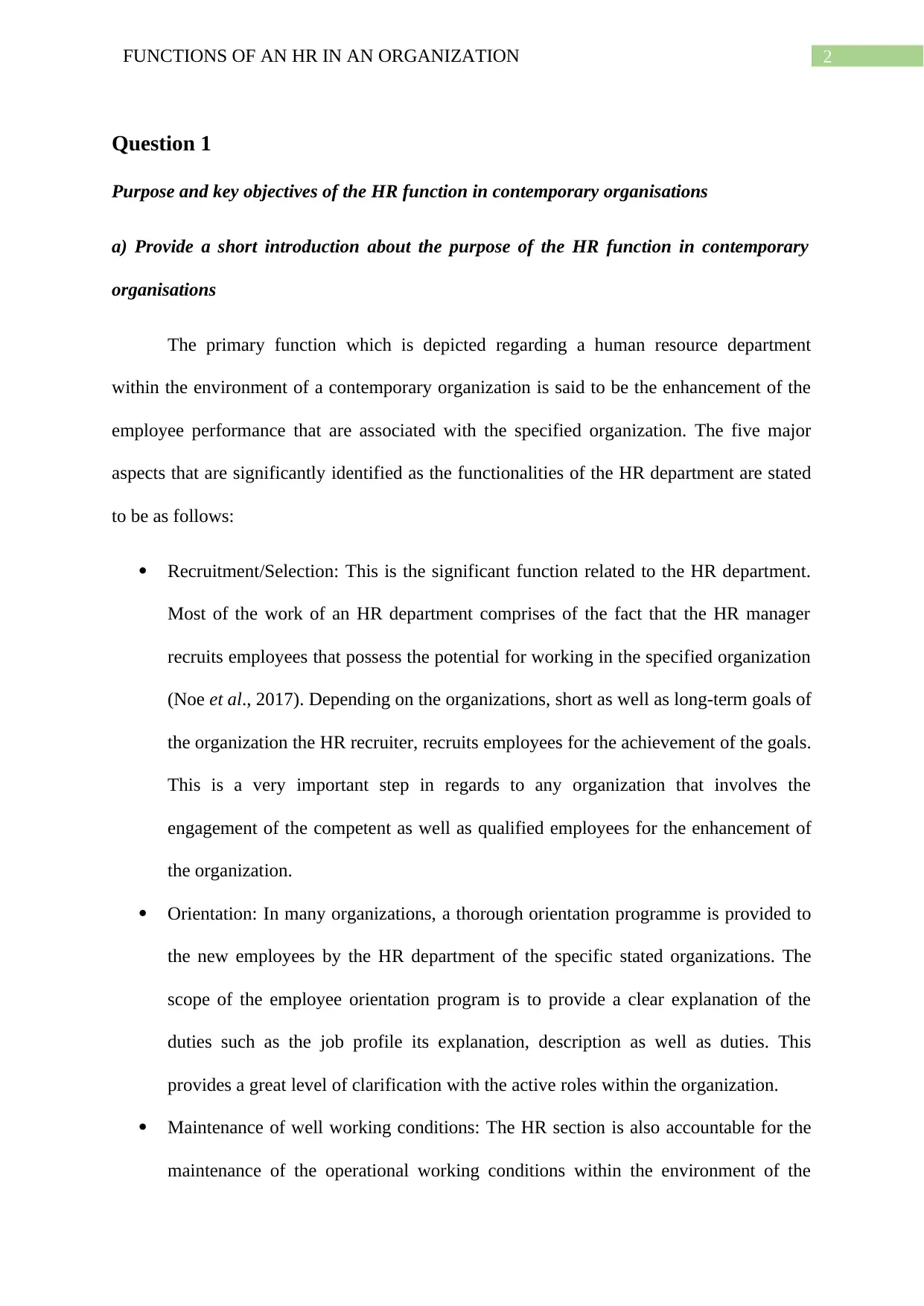
2FUNCTIONS OF AN HR IN AN ORGANIZATION
Question 1
Purpose and key objectives of the HR function in contemporary organisations
a) Provide a short introduction about the purpose of the HR function in contemporary
organisations
The primary function which is depicted regarding a human resource department
within the environment of a contemporary organization is said to be the enhancement of the
employee performance that are associated with the specified organization. The five major
aspects that are significantly identified as the functionalities of the HR department are stated
to be as follows:
Recruitment/Selection: This is the significant function related to the HR department.
Most of the work of an HR department comprises of the fact that the HR manager
recruits employees that possess the potential for working in the specified organization
(Noe et al., 2017). Depending on the organizations, short as well as long-term goals of
the organization the HR recruiter, recruits employees for the achievement of the goals.
This is a very important step in regards to any organization that involves the
engagement of the competent as well as qualified employees for the enhancement of
the organization.
Orientation: In many organizations, a thorough orientation programme is provided to
the new employees by the HR department of the specific stated organizations. The
scope of the employee orientation program is to provide a clear explanation of the
duties such as the job profile its explanation, description as well as duties. This
provides a great level of clarification with the active roles within the organization.
Maintenance of well working conditions: The HR section is also accountable for the
maintenance of the operational working conditions within the environment of the
Question 1
Purpose and key objectives of the HR function in contemporary organisations
a) Provide a short introduction about the purpose of the HR function in contemporary
organisations
The primary function which is depicted regarding a human resource department
within the environment of a contemporary organization is said to be the enhancement of the
employee performance that are associated with the specified organization. The five major
aspects that are significantly identified as the functionalities of the HR department are stated
to be as follows:
Recruitment/Selection: This is the significant function related to the HR department.
Most of the work of an HR department comprises of the fact that the HR manager
recruits employees that possess the potential for working in the specified organization
(Noe et al., 2017). Depending on the organizations, short as well as long-term goals of
the organization the HR recruiter, recruits employees for the achievement of the goals.
This is a very important step in regards to any organization that involves the
engagement of the competent as well as qualified employees for the enhancement of
the organization.
Orientation: In many organizations, a thorough orientation programme is provided to
the new employees by the HR department of the specific stated organizations. The
scope of the employee orientation program is to provide a clear explanation of the
duties such as the job profile its explanation, description as well as duties. This
provides a great level of clarification with the active roles within the organization.
Maintenance of well working conditions: The HR section is also accountable for the
maintenance of the operational working conditions within the environment of the
⊘ This is a preview!⊘
Do you want full access?
Subscribe today to unlock all pages.

Trusted by 1+ million students worldwide
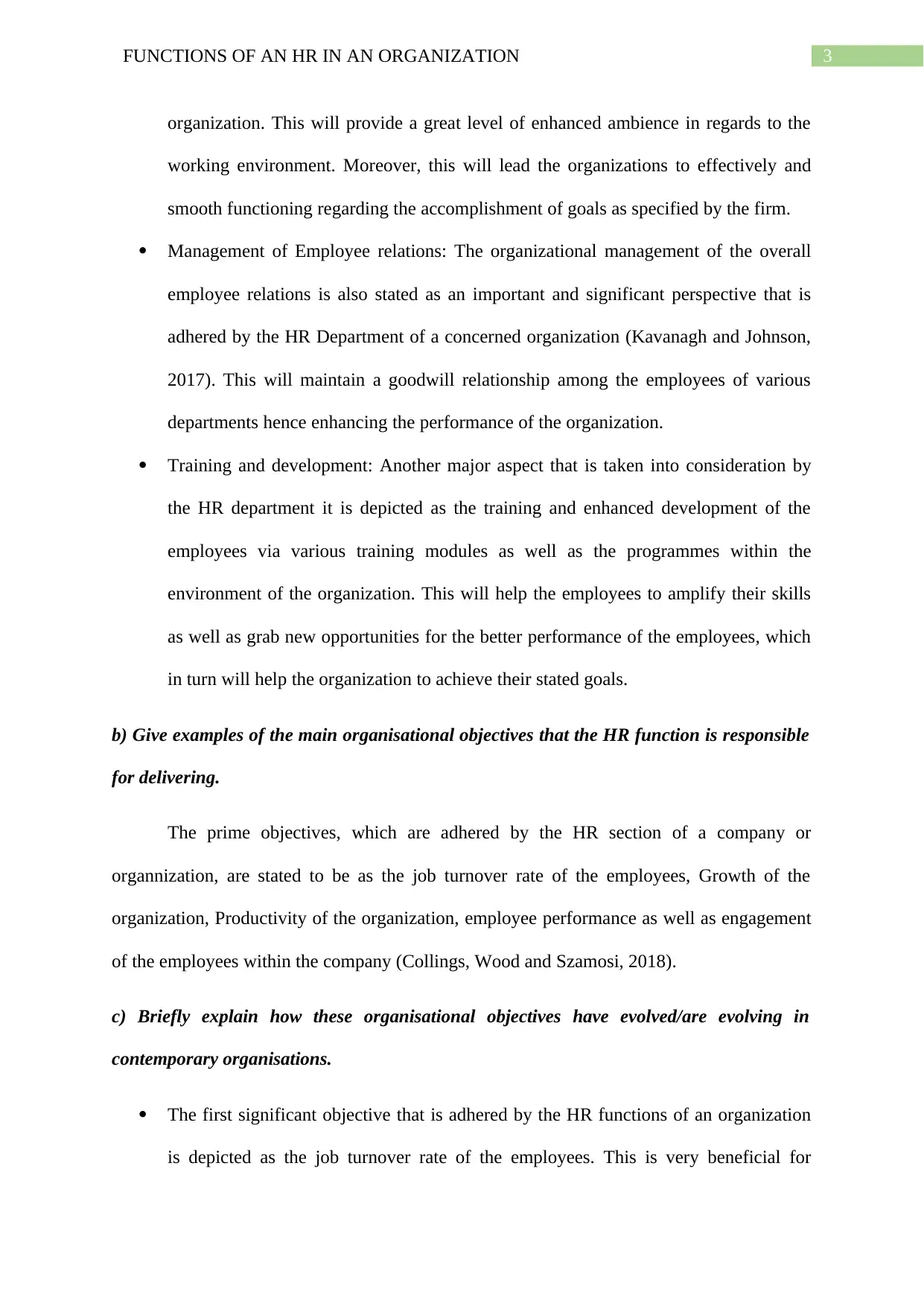
3FUNCTIONS OF AN HR IN AN ORGANIZATION
organization. This will provide a great level of enhanced ambience in regards to the
working environment. Moreover, this will lead the organizations to effectively and
smooth functioning regarding the accomplishment of goals as specified by the firm.
Management of Employee relations: The organizational management of the overall
employee relations is also stated as an important and significant perspective that is
adhered by the HR Department of a concerned organization (Kavanagh and Johnson,
2017). This will maintain a goodwill relationship among the employees of various
departments hence enhancing the performance of the organization.
Training and development: Another major aspect that is taken into consideration by
the HR department it is depicted as the training and enhanced development of the
employees via various training modules as well as the programmes within the
environment of the organization. This will help the employees to amplify their skills
as well as grab new opportunities for the better performance of the employees, which
in turn will help the organization to achieve their stated goals.
b) Give examples of the main organisational objectives that the HR function is responsible
for delivering.
The prime objectives, which are adhered by the HR section of a company or
organnization, are stated to be as the job turnover rate of the employees, Growth of the
organization, Productivity of the organization, employee performance as well as engagement
of the employees within the company (Collings, Wood and Szamosi, 2018).
c) Briefly explain how these organisational objectives have evolved/are evolving in
contemporary organisations.
The first significant objective that is adhered by the HR functions of an organization
is depicted as the job turnover rate of the employees. This is very beneficial for
organization. This will provide a great level of enhanced ambience in regards to the
working environment. Moreover, this will lead the organizations to effectively and
smooth functioning regarding the accomplishment of goals as specified by the firm.
Management of Employee relations: The organizational management of the overall
employee relations is also stated as an important and significant perspective that is
adhered by the HR Department of a concerned organization (Kavanagh and Johnson,
2017). This will maintain a goodwill relationship among the employees of various
departments hence enhancing the performance of the organization.
Training and development: Another major aspect that is taken into consideration by
the HR department it is depicted as the training and enhanced development of the
employees via various training modules as well as the programmes within the
environment of the organization. This will help the employees to amplify their skills
as well as grab new opportunities for the better performance of the employees, which
in turn will help the organization to achieve their stated goals.
b) Give examples of the main organisational objectives that the HR function is responsible
for delivering.
The prime objectives, which are adhered by the HR section of a company or
organnization, are stated to be as the job turnover rate of the employees, Growth of the
organization, Productivity of the organization, employee performance as well as engagement
of the employees within the company (Collings, Wood and Szamosi, 2018).
c) Briefly explain how these organisational objectives have evolved/are evolving in
contemporary organisations.
The first significant objective that is adhered by the HR functions of an organization
is depicted as the job turnover rate of the employees. This is very beneficial for
Paraphrase This Document
Need a fresh take? Get an instant paraphrase of this document with our AI Paraphraser

4FUNCTIONS OF AN HR IN AN ORGANIZATION
organizations like ADNOC as it can amplify the performance rate in respect to the
organization objectives as well as goals. Moreover, it is generally observed that the
employee turnover rate is greater in the organizations where the payment of the
employees are less. This primary factors that enhances the employee turnover rate are
depicted as the points like salary provided to the employees, the advantages adhered
by the organization, the absenteeism of the employees as well as performance of job
(Bratton and Gold, 2017).
The next important objective that is adhered by the HR department of an organization
is depicted as the growth of the organization. This is effectively related with the
retention as well as recruitment of the employees that are depicted to amplify the
performance of the organization in an effective manner.
Thirdly, the stated objective is identified as the Productivity of the organization. This
may be quite relatable to the employee performance as well as the skills or training
that is to be provided by the HR department in accordance to the amplification of the
productivity of the products and services of the specified organization.
The performance of the employees can also be stated as a prime objective that is
adhered by the HR department for the enhancement of the organizational goals thus
achieving them. This further enhances the productivity of the overall organization
thus making a global exposure of the organization.
The collaboration of the employees in every aspect of the organization is treated as
one of the major objectives that are accompanied by the HR department of an
organization for the achievement of the organizational goals. This collaboration or
engagement of the employees will help the organization to perform better with respect
to their stated goals and objectives.
organizations like ADNOC as it can amplify the performance rate in respect to the
organization objectives as well as goals. Moreover, it is generally observed that the
employee turnover rate is greater in the organizations where the payment of the
employees are less. This primary factors that enhances the employee turnover rate are
depicted as the points like salary provided to the employees, the advantages adhered
by the organization, the absenteeism of the employees as well as performance of job
(Bratton and Gold, 2017).
The next important objective that is adhered by the HR department of an organization
is depicted as the growth of the organization. This is effectively related with the
retention as well as recruitment of the employees that are depicted to amplify the
performance of the organization in an effective manner.
Thirdly, the stated objective is identified as the Productivity of the organization. This
may be quite relatable to the employee performance as well as the skills or training
that is to be provided by the HR department in accordance to the amplification of the
productivity of the products and services of the specified organization.
The performance of the employees can also be stated as a prime objective that is
adhered by the HR department for the enhancement of the organizational goals thus
achieving them. This further enhances the productivity of the overall organization
thus making a global exposure of the organization.
The collaboration of the employees in every aspect of the organization is treated as
one of the major objectives that are accompanied by the HR department of an
organization for the achievement of the organizational goals. This collaboration or
engagement of the employees will help the organization to perform better with respect
to their stated goals and objectives.
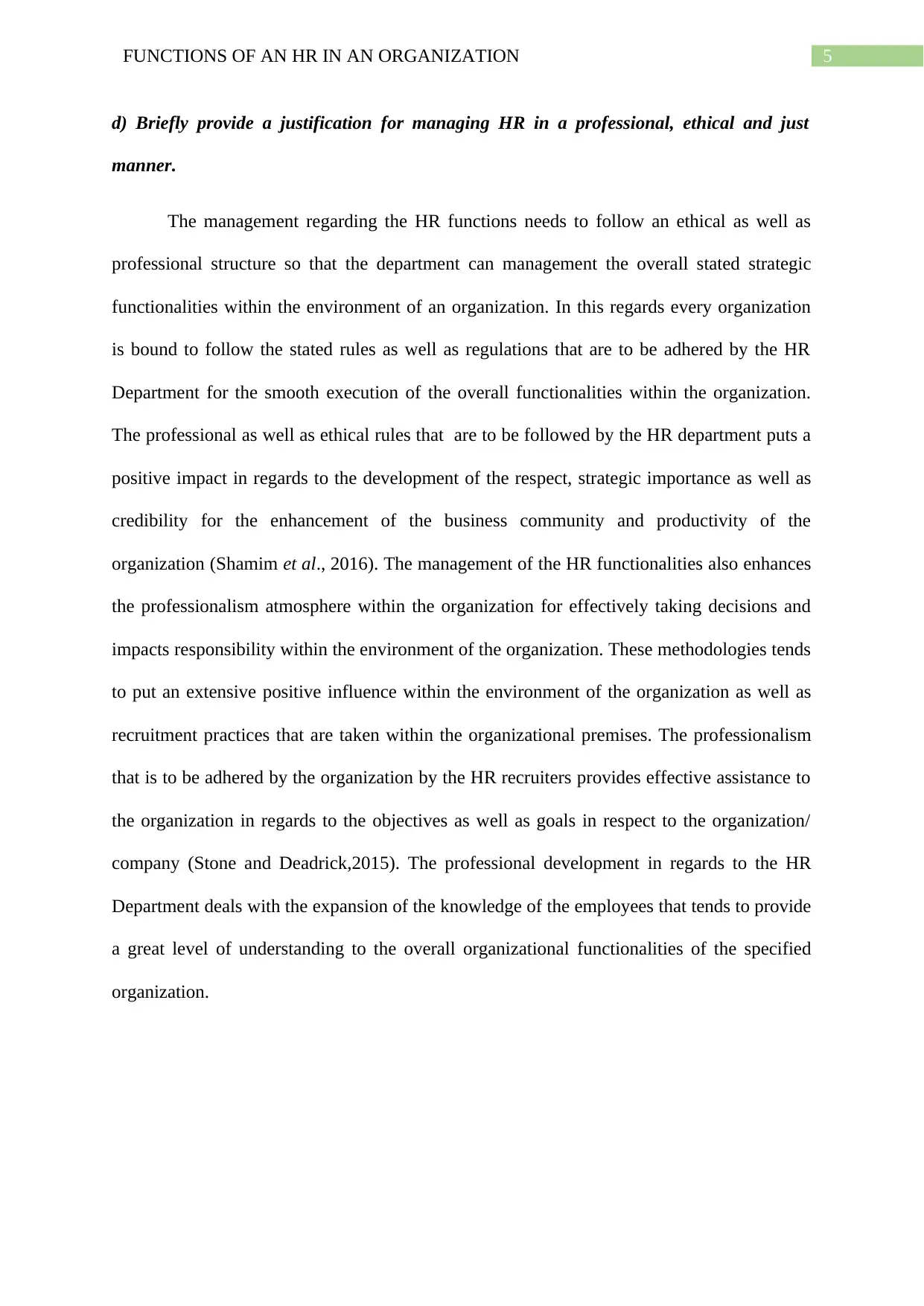
5FUNCTIONS OF AN HR IN AN ORGANIZATION
d) Briefly provide a justification for managing HR in a professional, ethical and just
manner.
The management regarding the HR functions needs to follow an ethical as well as
professional structure so that the department can management the overall stated strategic
functionalities within the environment of an organization. In this regards every organization
is bound to follow the stated rules as well as regulations that are to be adhered by the HR
Department for the smooth execution of the overall functionalities within the organization.
The professional as well as ethical rules that are to be followed by the HR department puts a
positive impact in regards to the development of the respect, strategic importance as well as
credibility for the enhancement of the business community and productivity of the
organization (Shamim et al., 2016). The management of the HR functionalities also enhances
the professionalism atmosphere within the organization for effectively taking decisions and
impacts responsibility within the environment of the organization. These methodologies tends
to put an extensive positive influence within the environment of the organization as well as
recruitment practices that are taken within the organizational premises. The professionalism
that is to be adhered by the organization by the HR recruiters provides effective assistance to
the organization in regards to the objectives as well as goals in respect to the organization/
company (Stone and Deadrick,2015). The professional development in regards to the HR
Department deals with the expansion of the knowledge of the employees that tends to provide
a great level of understanding to the overall organizational functionalities of the specified
organization.
d) Briefly provide a justification for managing HR in a professional, ethical and just
manner.
The management regarding the HR functions needs to follow an ethical as well as
professional structure so that the department can management the overall stated strategic
functionalities within the environment of an organization. In this regards every organization
is bound to follow the stated rules as well as regulations that are to be adhered by the HR
Department for the smooth execution of the overall functionalities within the organization.
The professional as well as ethical rules that are to be followed by the HR department puts a
positive impact in regards to the development of the respect, strategic importance as well as
credibility for the enhancement of the business community and productivity of the
organization (Shamim et al., 2016). The management of the HR functionalities also enhances
the professionalism atmosphere within the organization for effectively taking decisions and
impacts responsibility within the environment of the organization. These methodologies tends
to put an extensive positive influence within the environment of the organization as well as
recruitment practices that are taken within the organizational premises. The professionalism
that is to be adhered by the organization by the HR recruiters provides effective assistance to
the organization in regards to the objectives as well as goals in respect to the organization/
company (Stone and Deadrick,2015). The professional development in regards to the HR
Department deals with the expansion of the knowledge of the employees that tends to provide
a great level of understanding to the overall organizational functionalities of the specified
organization.
⊘ This is a preview!⊘
Do you want full access?
Subscribe today to unlock all pages.

Trusted by 1+ million students worldwide

6FUNCTIONS OF AN HR IN AN ORGANIZATION
Question 2
How HR objectives are delivered in different organisations.
a) Briefly summarise two different ways/models for delivering HR objectives to be
delivered in organisations.
The two models are paths that are abruptly followed by the Human Resources
department in regards to delivery of the Services within the organizations are depicted as
Shared Services Model and Outsourcing Model.
The first model that will be emphasized within this section is stated to be the shared
services model, which is depicted as one of the significant models that are used by the HR
department of different organizations to provide HR services. This model represents the
progression of the organization regarding the overall shared services that is adhered by the
HR department of the organizations (Bolden, 2016). It is viewed that most of the HR
department of different organizations started using the shared services model with the
adherence of a decentralized infrastructure. After this, the HR department adhered to the
centralized as well as standardized models. Moreover, the HR department finally uses
complex as well as global facing models within the organizations. It can be observed that a
major number of companies are heading towards the usage of the shared services
methodology for effectively delivering HR services within their organizations (Ketkar and
Puri, 2017). Most of the organizations found the shared services model to be favourable for
the distribution of the HR services to their employees. The term shared services depict the
provision regarding a service by the HR department within an organization, wherever that
service has been found previously in any of the other part of the organization (Boroughs and
Palmer, 2016). Thus, it can be said that the resource funding regarding the services is shared
Question 2
How HR objectives are delivered in different organisations.
a) Briefly summarise two different ways/models for delivering HR objectives to be
delivered in organisations.
The two models are paths that are abruptly followed by the Human Resources
department in regards to delivery of the Services within the organizations are depicted as
Shared Services Model and Outsourcing Model.
The first model that will be emphasized within this section is stated to be the shared
services model, which is depicted as one of the significant models that are used by the HR
department of different organizations to provide HR services. This model represents the
progression of the organization regarding the overall shared services that is adhered by the
HR department of the organizations (Bolden, 2016). It is viewed that most of the HR
department of different organizations started using the shared services model with the
adherence of a decentralized infrastructure. After this, the HR department adhered to the
centralized as well as standardized models. Moreover, the HR department finally uses
complex as well as global facing models within the organizations. It can be observed that a
major number of companies are heading towards the usage of the shared services
methodology for effectively delivering HR services within their organizations (Ketkar and
Puri, 2017). Most of the organizations found the shared services model to be favourable for
the distribution of the HR services to their employees. The term shared services depict the
provision regarding a service by the HR department within an organization, wherever that
service has been found previously in any of the other part of the organization (Boroughs and
Palmer, 2016). Thus, it can be said that the resource funding regarding the services is shared
Paraphrase This Document
Need a fresh take? Get an instant paraphrase of this document with our AI Paraphraser
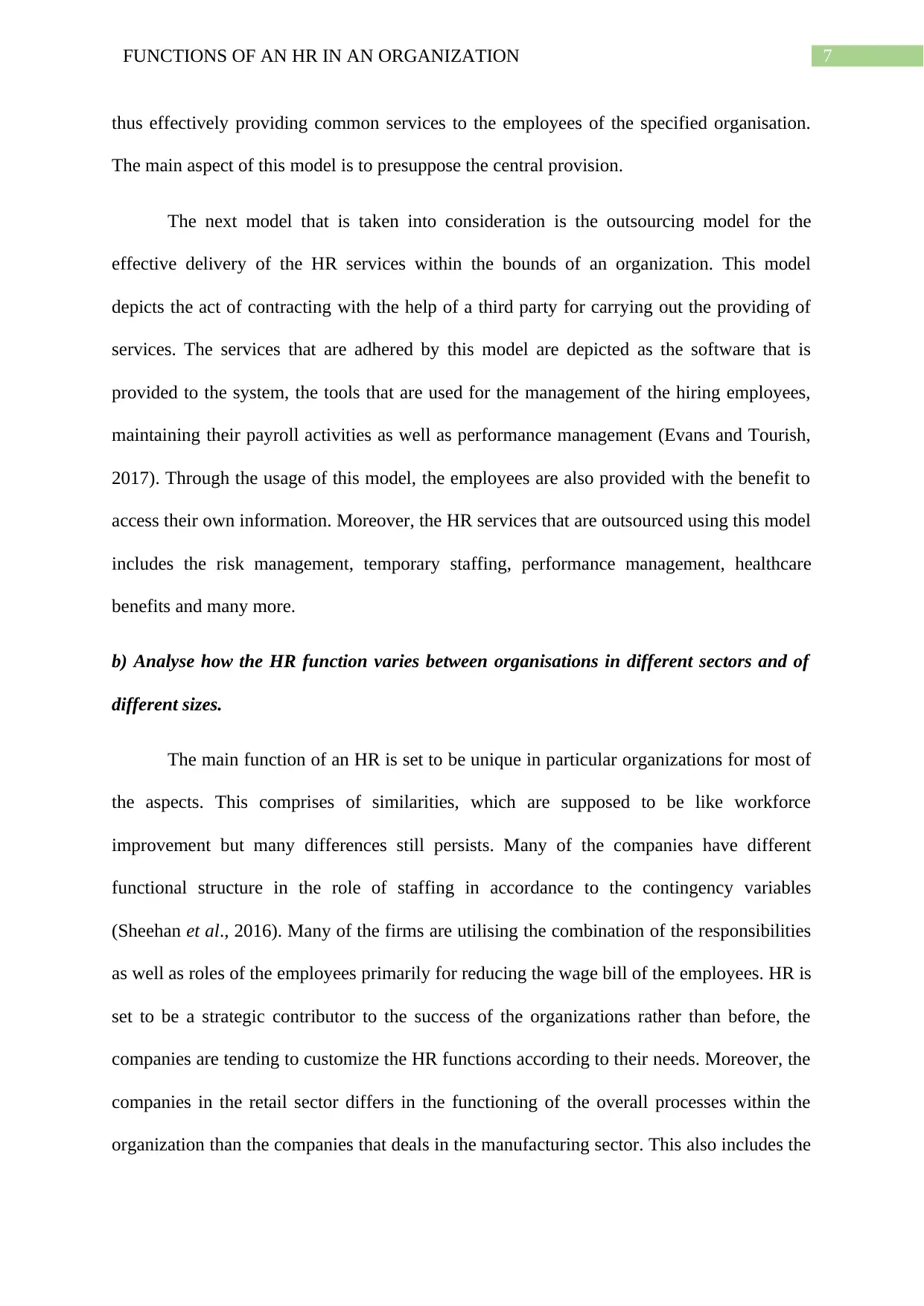
7FUNCTIONS OF AN HR IN AN ORGANIZATION
thus effectively providing common services to the employees of the specified organisation.
The main aspect of this model is to presuppose the central provision.
The next model that is taken into consideration is the outsourcing model for the
effective delivery of the HR services within the bounds of an organization. This model
depicts the act of contracting with the help of a third party for carrying out the providing of
services. The services that are adhered by this model are depicted as the software that is
provided to the system, the tools that are used for the management of the hiring employees,
maintaining their payroll activities as well as performance management (Evans and Tourish,
2017). Through the usage of this model, the employees are also provided with the benefit to
access their own information. Moreover, the HR services that are outsourced using this model
includes the risk management, temporary staffing, performance management, healthcare
benefits and many more.
b) Analyse how the HR function varies between organisations in different sectors and of
different sizes.
The main function of an HR is set to be unique in particular organizations for most of
the aspects. This comprises of similarities, which are supposed to be like workforce
improvement but many differences still persists. Many of the companies have different
functional structure in the role of staffing in accordance to the contingency variables
(Sheehan et al., 2016). Many of the firms are utilising the combination of the responsibilities
as well as roles of the employees primarily for reducing the wage bill of the employees. HR is
set to be a strategic contributor to the success of the organizations rather than before, the
companies are tending to customize the HR functions according to their needs. Moreover, the
companies in the retail sector differs in the functioning of the overall processes within the
organization than the companies that deals in the manufacturing sector. This also includes the
thus effectively providing common services to the employees of the specified organisation.
The main aspect of this model is to presuppose the central provision.
The next model that is taken into consideration is the outsourcing model for the
effective delivery of the HR services within the bounds of an organization. This model
depicts the act of contracting with the help of a third party for carrying out the providing of
services. The services that are adhered by this model are depicted as the software that is
provided to the system, the tools that are used for the management of the hiring employees,
maintaining their payroll activities as well as performance management (Evans and Tourish,
2017). Through the usage of this model, the employees are also provided with the benefit to
access their own information. Moreover, the HR services that are outsourced using this model
includes the risk management, temporary staffing, performance management, healthcare
benefits and many more.
b) Analyse how the HR function varies between organisations in different sectors and of
different sizes.
The main function of an HR is set to be unique in particular organizations for most of
the aspects. This comprises of similarities, which are supposed to be like workforce
improvement but many differences still persists. Many of the companies have different
functional structure in the role of staffing in accordance to the contingency variables
(Sheehan et al., 2016). Many of the firms are utilising the combination of the responsibilities
as well as roles of the employees primarily for reducing the wage bill of the employees. HR is
set to be a strategic contributor to the success of the organizations rather than before, the
companies are tending to customize the HR functions according to their needs. Moreover, the
companies in the retail sector differs in the functioning of the overall processes within the
organization than the companies that deals in the manufacturing sector. This also includes the
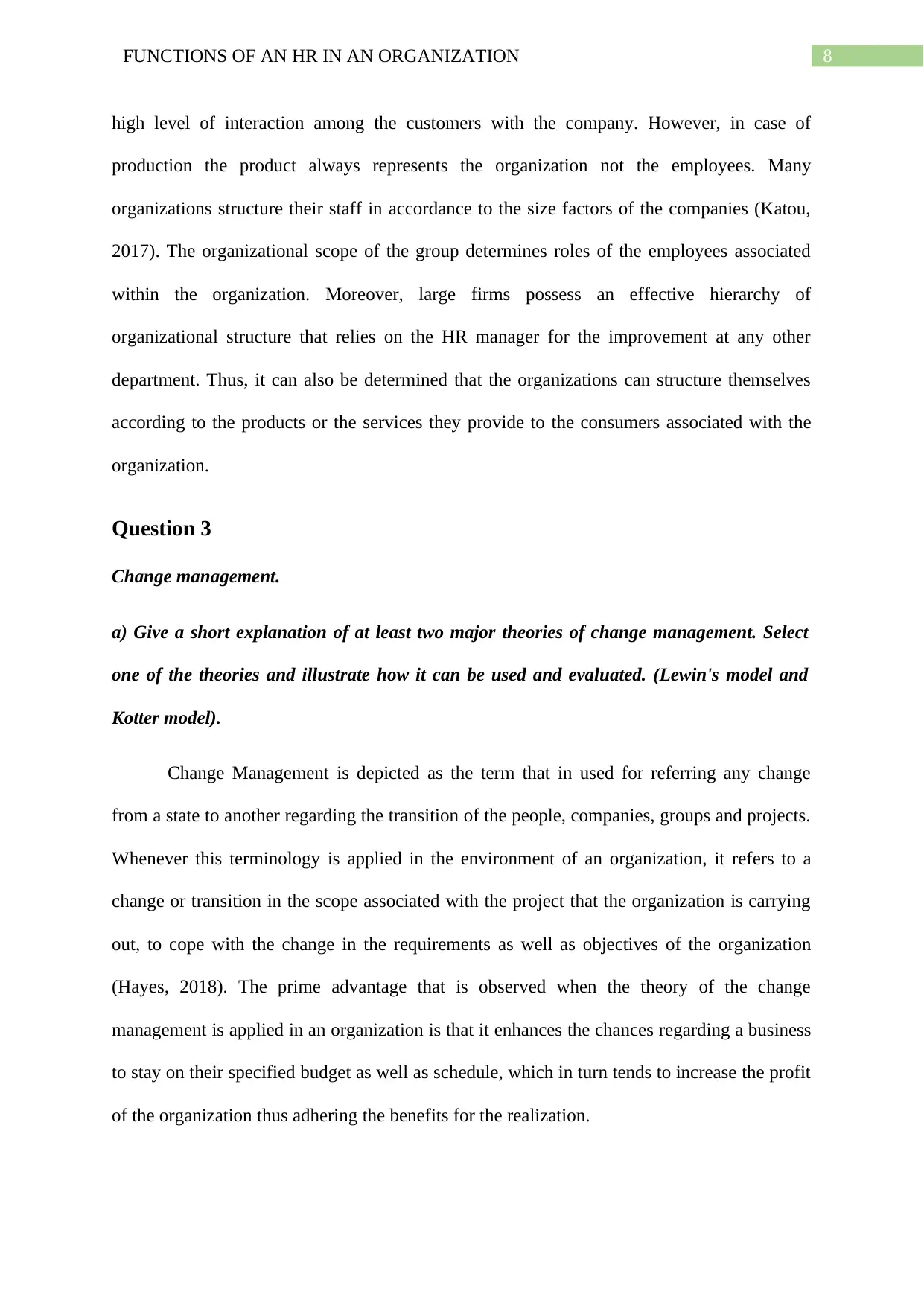
8FUNCTIONS OF AN HR IN AN ORGANIZATION
high level of interaction among the customers with the company. However, in case of
production the product always represents the organization not the employees. Many
organizations structure their staff in accordance to the size factors of the companies (Katou,
2017). The organizational scope of the group determines roles of the employees associated
within the organization. Moreover, large firms possess an effective hierarchy of
organizational structure that relies on the HR manager for the improvement at any other
department. Thus, it can also be determined that the organizations can structure themselves
according to the products or the services they provide to the consumers associated with the
organization.
Question 3
Change management.
a) Give a short explanation of at least two major theories of change management. Select
one of the theories and illustrate how it can be used and evaluated. (Lewin's model and
Kotter model).
Change Management is depicted as the term that in used for referring any change
from a state to another regarding the transition of the people, companies, groups and projects.
Whenever this terminology is applied in the environment of an organization, it refers to a
change or transition in the scope associated with the project that the organization is carrying
out, to cope with the change in the requirements as well as objectives of the organization
(Hayes, 2018). The prime advantage that is observed when the theory of the change
management is applied in an organization is that it enhances the chances regarding a business
to stay on their specified budget as well as schedule, which in turn tends to increase the profit
of the organization thus adhering the benefits for the realization.
high level of interaction among the customers with the company. However, in case of
production the product always represents the organization not the employees. Many
organizations structure their staff in accordance to the size factors of the companies (Katou,
2017). The organizational scope of the group determines roles of the employees associated
within the organization. Moreover, large firms possess an effective hierarchy of
organizational structure that relies on the HR manager for the improvement at any other
department. Thus, it can also be determined that the organizations can structure themselves
according to the products or the services they provide to the consumers associated with the
organization.
Question 3
Change management.
a) Give a short explanation of at least two major theories of change management. Select
one of the theories and illustrate how it can be used and evaluated. (Lewin's model and
Kotter model).
Change Management is depicted as the term that in used for referring any change
from a state to another regarding the transition of the people, companies, groups and projects.
Whenever this terminology is applied in the environment of an organization, it refers to a
change or transition in the scope associated with the project that the organization is carrying
out, to cope with the change in the requirements as well as objectives of the organization
(Hayes, 2018). The prime advantage that is observed when the theory of the change
management is applied in an organization is that it enhances the chances regarding a business
to stay on their specified budget as well as schedule, which in turn tends to increase the profit
of the organization thus adhering the benefits for the realization.
⊘ This is a preview!⊘
Do you want full access?
Subscribe today to unlock all pages.

Trusted by 1+ million students worldwide

9FUNCTIONS OF AN HR IN AN ORGANIZATION
The two major models or theories that will be briefly explained in this section are
chosen as Lewin’s Model and Kotter Model regarding the Change Management.
Lewin’s Model: This model is depicted as a significant as well as popular model among the
other models within the environment of the change management (Hornstein, 2015). This
model is also observed to be the most effective among the other models. This model tends to
make the change possible for the effective understanding in regards to the organizational as
well as infrastructure change. Kurt Lewin did the design and the creation of this model in
early 1950s. This is being used still today by many organizations. This model mainly
comprises of 3 significant stages that are described briefly below:
Unfreeze: This is the 1st stage in regards to the change process, which includes the
groundwork needed for the change within the organizational premises. This step is
adhered by the organization for making the preparation regarding the change and
determines the crucial as well need for the depicted change (Cummings, Bridgman
and Brown, 2016). The phase is determined to be important as most of the people in
the overall world tries to restrict the change but it is sometimes necessary to change
the order of the status present in the different organizations. The key aspect of this
step is to describe the people why the changes is needed as well as to state the profit
or benefits, which can be achieved after the change has been successfully implied.
Change: This is depicted as the next stage within the Lewin’s Model of Change
Management. This stage involves the real change or transition that takes place within
the environment where the theory of the change management is implied (Rosenbaum,
More and Steane, 2018). In this stage, it is observed that good quality of leadership as
well as assurance is significantly vital as these features are not only associated with
advantages but tends to create the procedure calmer for the employees or the
individuals that are identified to be involved within the overall stages of the process.
The two major models or theories that will be briefly explained in this section are
chosen as Lewin’s Model and Kotter Model regarding the Change Management.
Lewin’s Model: This model is depicted as a significant as well as popular model among the
other models within the environment of the change management (Hornstein, 2015). This
model is also observed to be the most effective among the other models. This model tends to
make the change possible for the effective understanding in regards to the organizational as
well as infrastructure change. Kurt Lewin did the design and the creation of this model in
early 1950s. This is being used still today by many organizations. This model mainly
comprises of 3 significant stages that are described briefly below:
Unfreeze: This is the 1st stage in regards to the change process, which includes the
groundwork needed for the change within the organizational premises. This step is
adhered by the organization for making the preparation regarding the change and
determines the crucial as well need for the depicted change (Cummings, Bridgman
and Brown, 2016). The phase is determined to be important as most of the people in
the overall world tries to restrict the change but it is sometimes necessary to change
the order of the status present in the different organizations. The key aspect of this
step is to describe the people why the changes is needed as well as to state the profit
or benefits, which can be achieved after the change has been successfully implied.
Change: This is depicted as the next stage within the Lewin’s Model of Change
Management. This stage involves the real change or transition that takes place within
the environment where the theory of the change management is implied (Rosenbaum,
More and Steane, 2018). In this stage, it is observed that good quality of leadership as
well as assurance is significantly vital as these features are not only associated with
advantages but tends to create the procedure calmer for the employees or the
individuals that are identified to be involved within the overall stages of the process.
Paraphrase This Document
Need a fresh take? Get an instant paraphrase of this document with our AI Paraphraser
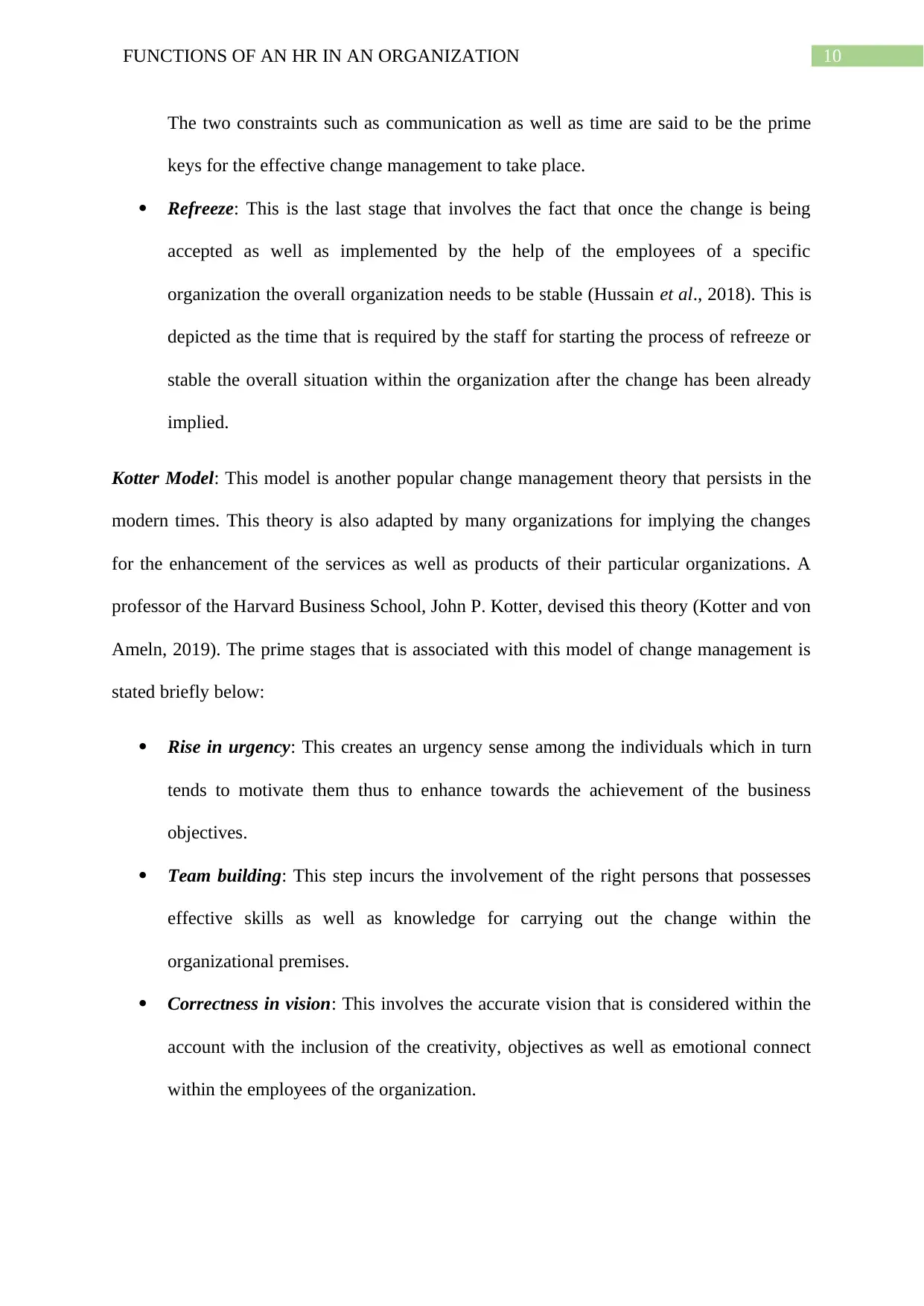
10FUNCTIONS OF AN HR IN AN ORGANIZATION
The two constraints such as communication as well as time are said to be the prime
keys for the effective change management to take place.
Refreeze: This is the last stage that involves the fact that once the change is being
accepted as well as implemented by the help of the employees of a specific
organization the overall organization needs to be stable (Hussain et al., 2018). This is
depicted as the time that is required by the staff for starting the process of refreeze or
stable the overall situation within the organization after the change has been already
implied.
Kotter Model: This model is another popular change management theory that persists in the
modern times. This theory is also adapted by many organizations for implying the changes
for the enhancement of the services as well as products of their particular organizations. A
professor of the Harvard Business School, John P. Kotter, devised this theory (Kotter and von
Ameln, 2019). The prime stages that is associated with this model of change management is
stated briefly below:
Rise in urgency: This creates an urgency sense among the individuals which in turn
tends to motivate them thus to enhance towards the achievement of the business
objectives.
Team building: This step incurs the involvement of the right persons that possesses
effective skills as well as knowledge for carrying out the change within the
organizational premises.
Correctness in vision: This involves the accurate vision that is considered within the
account with the inclusion of the creativity, objectives as well as emotional connect
within the employees of the organization.
The two constraints such as communication as well as time are said to be the prime
keys for the effective change management to take place.
Refreeze: This is the last stage that involves the fact that once the change is being
accepted as well as implemented by the help of the employees of a specific
organization the overall organization needs to be stable (Hussain et al., 2018). This is
depicted as the time that is required by the staff for starting the process of refreeze or
stable the overall situation within the organization after the change has been already
implied.
Kotter Model: This model is another popular change management theory that persists in the
modern times. This theory is also adapted by many organizations for implying the changes
for the enhancement of the services as well as products of their particular organizations. A
professor of the Harvard Business School, John P. Kotter, devised this theory (Kotter and von
Ameln, 2019). The prime stages that is associated with this model of change management is
stated briefly below:
Rise in urgency: This creates an urgency sense among the individuals which in turn
tends to motivate them thus to enhance towards the achievement of the business
objectives.
Team building: This step incurs the involvement of the right persons that possesses
effective skills as well as knowledge for carrying out the change within the
organizational premises.
Correctness in vision: This involves the accurate vision that is considered within the
account with the inclusion of the creativity, objectives as well as emotional connect
within the employees of the organization.
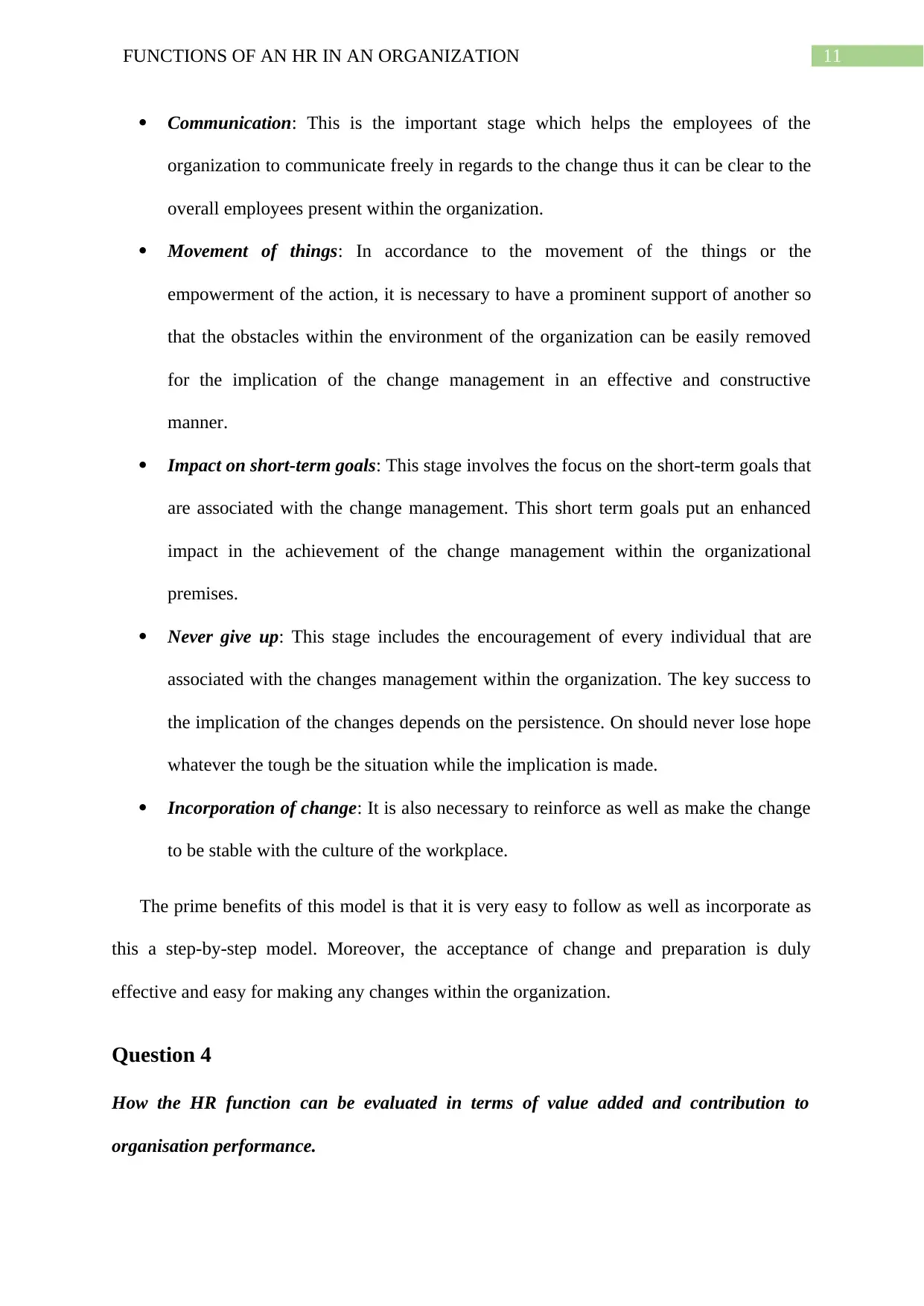
11FUNCTIONS OF AN HR IN AN ORGANIZATION
Communication: This is the important stage which helps the employees of the
organization to communicate freely in regards to the change thus it can be clear to the
overall employees present within the organization.
Movement of things: In accordance to the movement of the things or the
empowerment of the action, it is necessary to have a prominent support of another so
that the obstacles within the environment of the organization can be easily removed
for the implication of the change management in an effective and constructive
manner.
Impact on short-term goals: This stage involves the focus on the short-term goals that
are associated with the change management. This short term goals put an enhanced
impact in the achievement of the change management within the organizational
premises.
Never give up: This stage includes the encouragement of every individual that are
associated with the changes management within the organization. The key success to
the implication of the changes depends on the persistence. On should never lose hope
whatever the tough be the situation while the implication is made.
Incorporation of change: It is also necessary to reinforce as well as make the change
to be stable with the culture of the workplace.
The prime benefits of this model is that it is very easy to follow as well as incorporate as
this a step-by-step model. Moreover, the acceptance of change and preparation is duly
effective and easy for making any changes within the organization.
Question 4
How the HR function can be evaluated in terms of value added and contribution to
organisation performance.
Communication: This is the important stage which helps the employees of the
organization to communicate freely in regards to the change thus it can be clear to the
overall employees present within the organization.
Movement of things: In accordance to the movement of the things or the
empowerment of the action, it is necessary to have a prominent support of another so
that the obstacles within the environment of the organization can be easily removed
for the implication of the change management in an effective and constructive
manner.
Impact on short-term goals: This stage involves the focus on the short-term goals that
are associated with the change management. This short term goals put an enhanced
impact in the achievement of the change management within the organizational
premises.
Never give up: This stage includes the encouragement of every individual that are
associated with the changes management within the organization. The key success to
the implication of the changes depends on the persistence. On should never lose hope
whatever the tough be the situation while the implication is made.
Incorporation of change: It is also necessary to reinforce as well as make the change
to be stable with the culture of the workplace.
The prime benefits of this model is that it is very easy to follow as well as incorporate as
this a step-by-step model. Moreover, the acceptance of change and preparation is duly
effective and easy for making any changes within the organization.
Question 4
How the HR function can be evaluated in terms of value added and contribution to
organisation performance.
⊘ This is a preview!⊘
Do you want full access?
Subscribe today to unlock all pages.

Trusted by 1+ million students worldwide
1 out of 17
Related Documents
Your All-in-One AI-Powered Toolkit for Academic Success.
+13062052269
info@desklib.com
Available 24*7 on WhatsApp / Email
![[object Object]](/_next/static/media/star-bottom.7253800d.svg)
Unlock your academic potential
Copyright © 2020–2025 A2Z Services. All Rights Reserved. Developed and managed by ZUCOL.





